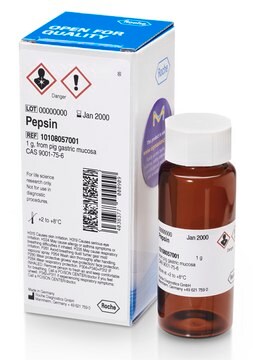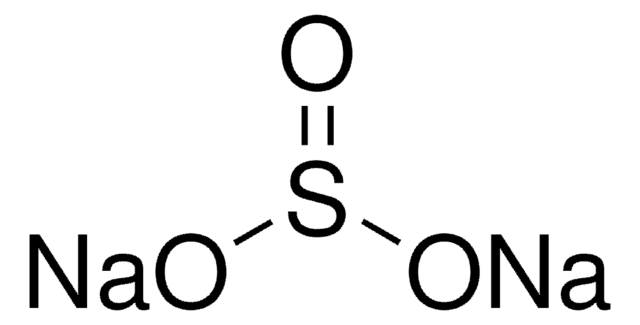77161
Pepsina
tested according to Ph. Eur.
Sinonimo/i:
Pepsina, Pepsina A
Autenticatiper visualizzare i prezzi riservati alla tua organizzazione & contrattuali
About This Item
Prodotti consigliati
agenzia
USP/NF
tested according to Ph. Eur.
Stato
powder
PM
35 kDa
N° accesso UniProt
Temperatura di conservazione
2-8°C
Informazioni sul gene
pig ... LOC396892(396892)
Cerchi prodotti simili? Visita Guida al confronto tra prodotti
Categorie correlate
Applicazioni
La scissione con pepsina può essere utilizzata per produrre frammenti F(ab′)2 di anticorpi. pepsina su www.sigma-aldrich.com/enzymeexplorer.
Azioni biochim/fisiol
Scissione preferenziale: residui idrofobi e aromatici nelle posizioni P1 e P1′. Scinde i legami Phe-Val, Gln-His, Glu-Ala, Ala-Leu, Leu-Tyr, Tyr-Leu, Gly-Phe, Phe-Phe e Phe-Tyr nella catena β dell′insulina.
Risultati analitici
Il PH ottimale è compreso tra 2 e 4. Attivo in 4 M di urea e 3 M di guanidina HCl. Stabile a 60 °C. La pepsina viene inattivata irreversibilmente in presenza di pH 8,0 - 8,5.
Esclusione di responsabilità
Sales restrictions may apply.
Avvertenze
Danger
Indicazioni di pericolo
Consigli di prudenza
Classi di pericolo
Eye Irrit. 2 - Resp. Sens. 1 - Skin Irrit. 2 - STOT SE 3
Organi bersaglio
Respiratory system
Codice della classe di stoccaggio
11 - Combustible Solids
Classe di pericolosità dell'acqua (WGK)
WGK 1
Punto d’infiammabilità (°F)
Not applicable
Punto d’infiammabilità (°C)
Not applicable
Dispositivi di protezione individuale
dust mask type N95 (US), Eyeshields, Faceshields, Gloves
Scegli una delle versioni più recenti:
Possiedi già questo prodotto?
I documenti relativi ai prodotti acquistati recentemente sono disponibili nell’Archivio dei documenti.
I clienti hanno visto anche
Heather H Pua et al.
Cell reports, 26(4), 933-944 (2019-01-24)
Extracellular RNAs (exRNAs) can be released by numerous cell types in vitro, are often protected within vesicles, and can modify recipient cell function. To determine how the composition and cellular sources of exRNAs and the extracellular vesicles (EVs) that carry them
Liqing Zhou et al.
Behavioural brain research, 364, 374-382 (2018-01-18)
Accumulating evidence supports an increase in emotional and behavioral problems in patients with food allergy, but the underlying mechanism remains poorly understood. Here we found that in addition to inducing an increase of allergic factors in serum, food allergy also
Haiyu Qi et al.
Cell reports, 31(6), 107621-107621 (2020-05-14)
Follicular helper T cells (Tfhs) are essential for germinal center (GC) B cell maturation and antibody development. However, the intrinsic mechanisms that regulate Tfh differentiation are largely unknown. Here, we demonstrate that the frequencies of Tfhs and GC B cells, as
Xinghui Li et al.
Immunity, 50(3), 576-590 (2019-02-17)
Elevated glucose metabolism in immune cells represents a hallmark feature of many inflammatory diseases, such as sepsis. However, the role of individual glucose metabolic pathways during immune cell activation and inflammation remains incompletely understood. Here, we demonstrate a previously unrecognized
Chuan-Hsiao Han et al.
Food chemistry, 138(2-3), 923-930 (2013-02-16)
Our previous report showed that yam dioscorin and its peptic hydrolysates exhibit radical scavenging activities; however, the functions of these peptic hydrolases are still under investigation. In this study, the thiol-containing peptides derived from computer-aided simulation of pepsin hydrolysis of
Il team dei nostri ricercatori vanta grande esperienza in tutte le aree della ricerca quali Life Science, scienza dei materiali, sintesi chimica, cromatografia, discipline analitiche, ecc..
Contatta l'Assistenza Tecnica.










